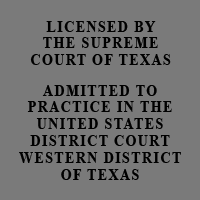Texas Discectomy and Fusion Surgery Lawyer Represents Victims of Medical Negligence
Texas Discectomy and Fusion Surgery Lawyer reviews catastrophic injury and death medical negligence cases. More specifically, he helps victims and their families after a mistake or other negligence causes catastrophic injuries, permanent paralysis, physical impairment or death. Further, he reviews medical records and works with experts to determine why fusion surgeries have failed and if medical malpractice occurred. These failed cervical and lumbar surgeries can be caused by a variety of factors including improper use of implants, improperly placed hardware, negligently implanted devices, defective spinal-devices or hardware, doctor carelessness, off-label use of stimulators or surgeon negligence. If you or a family member have been the victim of a failed laminectomy or failed discectomy, please feel free to send an e-mail to Texas Discectomy and Fusion Surgery Lawyer, Jason Coomer or please feel free to submit an inquiry via our submission form.
Serious Spine Injuries Commonly Require Surgical Intervention
A serious back injury or spinal cord injury can cause extreme pain and paralysis requiring additional back surgery, physical therapy, home health care providers, and medical devices & equipment. Recovering from a back injury or spinal cord injury can take years and in many instances full impairment may never be obtained. In the more severe cases, the injured person may need help in their day to day life and may not be able to do many of things that they were able to do prior to the traumatic back injury or spinal cord injury.
Cervical Surgery and Lumbar Surgery Are Typically Intended To Decompress a Nerve Root That Is Pinched, Stabilize a Painful Joint, or Implant a Device to Help Suppress a Person's Pain
When considering going through back or neck surgery, please keep in mind that spine surgery is basically able to accomplish only two things: decompress a nerve root that is pinched, or stabilize a painful joint. In other words, back surgery or spine surgery cannot literally cut out a patient’s pain. It is only able to change anatomy. Therefore, it is important that an anatomical lesion (injury) that is a probable cause of back pain should be identified prior to rather than after back surgery or spine surgery is performed. In other words, it is important for your surgical team to have a surgical objective prior to cutting into the patient.
Further, it is best if you and your surgeon understand the goal of the back surgery or neck surgery prior to the surgery being performed. Fortunately, medical science has come a long way in treating back injuries and spinal cord injuries. Good neurosurgeons and orthopedic surgeons can often perform back surgery that can help severe spinal cord and back injuries.
Unnecessary Discectomy Surgery or Fusion Surgery Can Be The Result of Negligence as well as "For Profit" Assembly Line Back Surgeons
Some back specialists are discouraging the use of surgery as a therapeutic technique for patients with back pain. These back specialists have realized the as many as 99 percent of the back surgical cases can be treated with less aggressive and risky treatments. In fact, the use of back surgery may be extremely high because some surgeons are quick to perform surgery on patients with good insurance, TRICARE benefits, or Medicare. Failed Back Syndrome: The Disturbing Statistics | DocGuide
Patients and their families should beware of assembly line mass patient surgeons and clinics that are only interested in performing as many surgeries as they can for the purpose of making a profit. It is important that the medical professionals on their surgical team are interested in their health and can fully explain the objectives of the surgery as well as possible complications. The "for profit" surgeons and clinics can often perform unnecessary surgeries, push patients that are not fit for surgery into having ill advised surgeries, or bypass more conservative treatments and rush patients to unnecessary back or neck surgeries.
Injured Vertebrae, Injured Discs, or an Injured Spinal Cord Can Sometimes Be Relieved By Cervical Decompression Surgery, Cervical Fusion Surgery, Lumbar Decompression Surgery, Lumbar Fusion Surgery, Spinal Implant Surgery or Other Back Surgery
The human spinal cord is a nerve center in the body that is surrounded by 33 bones or vertebrae. Located between each vertebrae is a spinal disc which is a liquid filled disc shaped pouch. These discs are stacked on top of one another and act as shock absorbers allowing the spine to flex, bend, and twist. When functioning properly, the vertebrae and discs protect the spinal cord allowing nerve impulses to travel from and to the brain to other parts of the body. This allows us to experience sensations, move our bodies, and control many bodily functions.
Problems arise when the vertebrae, discs, or spinal cord are injured. Broken vertebrae can damage and impinge on discs or the spinal cord causing extreme pain, numbness, and loss of control of bodily functions. Back injuries can occur through many different types of traumatic events or failed back surgery and can result in paralysis, pain, and impairment. Depending where and how severe the injury is will determine what type and how severe the paralysis.
Medical science has come a long way in treating back injuries, neck injuries, and other spinal cord injuries. Well trained neurosurgeons, orthopedic surgeons, and surgical teams can often help patients with severe back pain, paralysis, neck pain, and/or disability by performing back surgery and neck surgery. These spine surgeries can often alleviate pain by removing anatomical lesions.
However, please keep in mind that failed back and neck surgeries are common. The term failed back surgery syndrome refers to the condition of patients who have not had a successful result with back surgery or spine surgery and have experienced continued pain after surgery. These failed back surgeries and neck surgeries can be caused by several factors including careless back surgeons, negligent back surgeons, intoxicated back surgeons, defective implants, misplaced implants, defective hardware, misplaced hardware, metal fatigue, improper follow up medical care, improper surgery candidates, and unqualified back surgeons. These failed back surgeries and failed neck surgeries can cause a patient to suffer permanent impairment, intense pain, and paralysis. It is extremely important that patients considering back surgery or neck surgery, are well informed as to the qualifications of their surgeon as well as the risks and potential benefits of the back surgery or neck surgery.
Spinal Fusion Surgery Can Result in Permanent Disability and Pain
Spinal Fusion Surgery uses a bone graft to stop motion and impingement in the spine, thus reducing the patient's pain. A Lumbar Spinal Fusion uses a bone graft in the lumbar or lower part of a person's back to stop the motion at a painful vertebral segment for the purpose of decreasing pain generated from the damaged part of the lumbar or lower back. A Cervical Spinal Fusion uses a bone graft in the cervical or neck/upper back to stop the motion at a painful vertebral segment for the purpose of decreasing pain generated from the damaged part of the cervical back, upper back, or neck.
Unfortunately, spinal fusions can fail for several different reasons. A common reason for a failed fusion is that the patient's spine does not properly fuse. An example of this type of fusion failure occurs when there is not enough support to hold the spine, while the spine is fusing. These failed fusions can be caused by hardware failures. In these situations, spinal hardware such as pedicle screws can be misplaced or can be defective causing the internal splint to fail. The internal split is intended to hold the spine while the fusion takes place after spine surgery. Its failure can cause spinal instability and prevent the fusion from being able to fully fuse. Other potential reasons for a failed fusion include that the fusion does not stop the impingement or the fusion causes problems in other areas of the spine.
In general, surgeons estimate that it takes at least three months to get a solid fusion after surgery, and it can take up to a year in some patients to get a solid fusion after the spine surgery. Therefore, in some patients with unstable spines, after surgery it can sometimes be a race between the spine fusing (patient’s bone providing support for the spine) and the metal failing (causing fusion failure). It is therefore important to have follow up care after surgery and for the patient to be advised as to the potential dangers of applying too much stress on the back during the healing process. It is also important for the hardware that is implanted in a patient to be able to last long enough for a solid fuse to occur.
Also, it is important to keep in mind that even if a solid fusion is not obtained through the spine surgery, the hardware if it does keep intact and provides good stability to the spine, the patient may still achieve effective back pain relief with the spine surgery. In many cases, achieving spinal stability alone is more important than obtaining a solid fusion from the spine surgery.
Laminectomy and Spinal Decompression Surgery
Decompression surgery involves removing a small portion of the bone over the nerve root and/or disc material from under the nerve root to relieve pinching of the nerve and provide more room for the nerve to heal. A Lumbar Decompression Surgery (Laminectomy) involves removing a small portion of the bone in the lumbar or lower part of a person's back which is applying pressure on the nerve root and/or disc material from under the nerve root to relieve pinching of the nerve and provide more room for the nerve to heal. Likewise, a Cervical Decompression Surgery involves removing a small portion of the bone over the nerve root and/or disc material from under the nerve root in the cervical or neck/upper back to relieve pinching of the nerve and provide more room for the nerve to heal. Depending on the patient's condition including cervical impingement an Ananterior Cervical Decompression Surgery (Discectomy), a Posterior Cervical Decompression and Fusion Surgery (Microdiscectomy), or a combination of operating from the front and back of the patient may be used.
Spinal Decompression and Fusion Surgery Can De-stablilize the Spine
In some patients, decompression surgery will sometimes de-stabilize the spine and create the need for a fusion to add stability. In these cases spinal instrumentation (such as a small plate) can also be used to help add stability to the spinal construct. Depending on the patient's cervical impingement an Ananterior Cervical Decompression Surgery (Discectomy) or a Posterior Cervical Decompression (Microdiscectomy) and Fusion Surgery (Discectomy) or a combination of operating from the front and back of the patient may be used.
Decompression and fusion surgeries are often used together because decompression surgery involves removing a small portion of the bone which will often result in spine instability. Thus, decompression surgery or a laminectomy will sometimes de-stabilize the spine and create the need for a fusion to add stability. In these cases a internal splint or spinal instrumentation (such as a small plate and pedicle screws) can also be used to help add stability to the spinal construct. This decompression and fusion surgery includes Cervical Decompression and Fusion Surgery as well as Lumbar Decompression and Fusion Surgery.
Unfortunately, some careless surgeons will fail to stabilize the spine during a decompression surgery resulting in spine instability that can result in severe pain, paralysis, or disability. Other surgeons can fail to remove the bone or anatomical lesion (injury) that is causing the impingement and pain. Both of these failures can result in the need for additional surgeries.
Fusion and Decompression Surgery by its nature involves incisions into and manipulation of the spine, surrounding nerves, and tissue, any mistake by a surgeon during the surgery can have potentially serious injuries and damages for the patient. These injuries and damages can include permanent nerve injuries, blood clots, incontinence, and even death if the surgery does not go as planned. Additionally, a medical professionals’ failure to monitor patients for potentially crippling and/or fatal side effects can be medical malpractice should these injuries occur.
In addition to the above back surgeries, there are numerous implants and spinal devices as well as injections that can help people recover from back and spinal cord injuries. These procedures and devices can reduce pain caused by back injuries as well as help reduce impairment. However, it is extremely important when considering back surgery or other spinal procedures to make sure that you have a competent doctor and medical staff that you trust. A failed back surgery or defective medical device can cause more impairment, pain, and health problems than none at all. It is important to understand the risks of any back surgery or medical treatment.
Further, it is important to understand that some medical doctors feel that too many surgeons are using back stimulators for treating back pain when the indication is for neuropathic pain instead. It is extremely important to have a medical doctor and surgical team that understands the cause of your back pain and properly treats the underlying cause rather than uses an implant or improper surgical procedure to mask pain. Further, it is also important for the surgical team to understand the proper methods for implanting any back stimulator. Improper implantation of a back stimulator can cause serious problems.
For Profit Medical Services Can Sometimes Push Unnecessary or Unwise Surgery
Unfortunately, there are also medical clinics, medical implant sales people, and doctors that are more interested in profit and their bottom line than what is best for a patient. Some of these medical professionals carelessly cause painful and difficult conditions to become much worse by paralyzing patients that are seeking relief from pain.
As medical budgets go down and healing people becomes more of a "for profit" business, cost cutting measures are causing more medical mistakes. Overworked surgeons, doctors, residents, and nurses are much more likely to make mistakes than well rested health care professionals.
Medical mistakes also happen more often when no one is watching. It is extremely important when you are in the hospital to have someone that is with you and watching out for your well being. This is especially true if you have an allergy to certain types of medicines. Communication with your health care professionals is also important and can greatly limit medical mistakes.
Texas Discectomy and Fusion Surgery Lawyer Help Victims of Medical Negligence
Texas discectomy and fusion surery lawyers help victims of medical negligence and doctor mistakers. They handle unnecessary spinal surgery cases and improper implant cases. To begin a review of a case, they need to know when the surgery occurred, who performed the surgery, what injuries were caused and if a subsequent health care provider believes negligence has occurred. They also need to review medical records regarding the surgery and after case. If you need a Texas Failed Discectomy Lawyer, Failed Laminectomy Lawyer, and Failed Fusion Spine Surgery Lawyer with knowledge of Failed Back Surgery Medical Malpractice Lawsuits and/or Failed Back Surgery Implant, please feel free send an e-mail message to Texas Failed Discectomy Lawyer and Failed Laminectomy Lawyer Jason Coomer. His office frequently works with other Failed Back Surgery Medical Malpractice Lawyers throughout Texas and the United States.
Feel Free to Contact Us with any Questions
Associations




